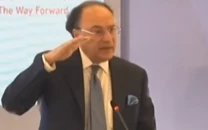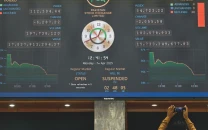Govt pitches Rs3.77tr deficit target to IMF
IMF seeks further adjustment to budget gap; discussions will begin this week

The government has pitched the budget deficit target of 4.8% of the total size of economy, or Rs3.77 trillion, to the International Monetary Fund (IMF) for the next fiscal year, which the global lender wants to be adjusted further through a combination of expenditure cuts and additional revenue mobilisation.
Further discussions with the IMF on fiscal year 2022-23’s budget will begin this week to close the gap and reach a deal in June.
But the new coalition government faces the dual challenge of restoring Pakistan’s credibility in the eyes of international lenders due to the broken past promises and simultaneously winning concessions from them.
Sources told The Express Tribune that during the inconclusive Doha talks, the government had proposed the budget deficit target for the next fiscal year at Rs3.77 trillion, or 4.8% of gross domestic product (GDP).
The primary deficit target, excluding interest payments, had been proposed at 0.5% of GDP, or less than Rs400 billion, for the next fiscal year, they added.
However, the IMF did not accept both the numbers, terming the 4.8% budget deficit projection at the lower end in the absence of concrete measures. It demanded that Pakistan should meet its commitment and generate a primary budget surplus instead of proposing the primary deficit target, they added.
Pakistan informed the IMF that any budget made on the assumption of achieving the primary budget balance would be unrealistic and would result in starting the new fiscal year on a wrong footing, said the sources.
Under the 2019 Extended Fund Facility, the IMF’s key goal is the primary budget target, which in present circumstances can only be achieved through a combination of development expenditure cuts and enhancing revenue collection. However, the gains made through higher revenue mobilisation and development spending cuts are lost by an increase in the key policy rate by the central bank to 13.75%.
Due to the last government’s failure in fulfilling the promises made with the IMF, there was a serious credibility crisis, said Dr Aisha Pasha, the Minister of State for Finance and Revenue. Our success was that we brought the IMF back to the negotiating table and covered significant ground, said Dr Pasha.
The Minister of State said that Pakistan shared the doable fiscal numbers with the IMF and further discussions on these numbers would begin on Wednesday.
Finance Minister Miftah Ismail said on Saturday that after an increase in fuel prices by Rs30 per liter, he was very close to clinching a deal with the IMF. Ismail hoped to finalise the staff level agreement in June, preferably around June 10th budget time.
Pakistan and the IMF have so far held two unsuccessful rounds of talks to reach a staff-level agreement on the completion of the 7th review, first held by the Pakistan Tehreek-e-Insaf government in March and second by the coalition government this month.
The sources said that one of the hurdles in an agreement on the next fiscal year’s framework was the increase in electricity prices and the subsidies needed to bridge the gap. The Ministry of Finance has informed the Power Division that it was ready to provide around Rs740 billion in electricity subsidies for the next fiscal year. The amount is roughly Rs110 billion higher than this fiscal year.
It would still require increasing the electricity prices in the range of Rs10 to Rs12 per unit, including withdrawal of the temporary Rs5 per unit subsidy announced by the last PTI government for four months.
The sources said that the interest payments for the next fiscal year are currently projected at around Rs3.56 trillion or 4.5% of the GDP. But one calculation suggests that the figure could reach Rs3.8 trillion if the central bank further increases the interest rates in July.
For this fiscal year, the estimated overall budget deficit target is 6.5% of the GDP, although the Finance Minister Ismail said that it could cross 8% of the GDP.
For this fiscal year, the estimated cost of the interest payments on the government loans is Rs3.1 trillion. However, the figure may further shoot up due to rupee devaluation and its impact on the foreign debt servicing.
The defense spending for the next fiscal year is projected at less than Rs1.55 trillion, up from nearly Rs1.4 trillion.
The Planning Ministry last week issued budget ceilings to the ministries based on Rs800 billion PSDP for the next year. The higher development spending may further increase the gap between the government and the IMF projections.
The FBR’s revenue target is estimated at around Rs7.2 trillion while another Rs2 trillion could be arranged as non-tax receipts. The Ministry of Finance had initially estimated Rs450 billion as the Petroleum Development Levy target but it was giving a second thought to it, as the government will have to restore the petroleum levy at the beginning of the new fiscal year, starting in July.
Published in The Express Tribune, May 31st, 2022.
Like Business on Facebook, follow @TribuneBiz on Twitter to stay informed and join in the conversation.



















COMMENTS
Comments are moderated and generally will be posted if they are on-topic and not abusive.
For more information, please see our Comments FAQ